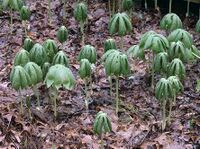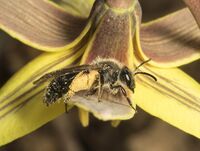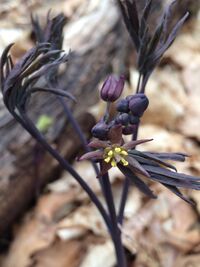Spring Ephemerals
Spring Ephemerals are a subcategory of wildflowers which can be found on the forest floor in temperate areas and go through the entirety of their life cycle before the forest canopy closes in early summer. These flowers are found across a variety of plant families including: Berberidaceae (Barberry), Liliaceae (Lily), Portulacaceae (Purslane), and Geraniaceae (Geranium). There are other types of ephemeral plants (including desert ephemerals, which bloom quickly after a heavy rainfall in desert ecosystems) however this page discusses spring ephemerals which take advantage of the sunlight available in temperate deciduous forests in the early spring [1].

Description

Typically spring ephemerals are herbaceous, low growing, perennial wildflowers with short lifecycles and belowground storage organs which store excess sugars and carbohydrates that the plants live off of for the remainder of the year once they go dormant again. These plants are often the earliest sprouting plants within the forest—since they have to take advantage of the sunlight before the trees grow their leaves and shade out the plants on the forest floor—and will have produced flowers, released seeds, and reentered dormancy before most other plants have begun to produce leaves [2].
A major advantage that many spring ephemerals share is the possession of an underground storage organ of some sort, like a bulb, corm, or rhizome. These organs allow ephemerals to store the excess quantities of sugars and carbohydrates they made during the early spring and summer in order to draw on those stores after they no longer have access to the sunlight.

Reproductive Adaptations
Since ephemerals are spread out across many different plant families there is not one shared method of reproduction, but rather many different reproduction methods that allow these plants to reproduce quickly and efficiently. The main reproductive attribute that most ephemerals share is that they are perennials which flower and produce seeds within 40-60 days of sprouting [2]. Some ephemerals, like Mayapple (Podophyllum peltatum), can partially avoid the energetic costs of seed production by reproducing asexually and creating clonal patches across the forest floor, only producing seeds and fruit after reaching maturity after about 4 years [5]. Meanwhile other spring ephemerals will wait up to 7 years before producing any flowers or seeds, the Trout lily is an example of this strategy [6].

Ecological Importance

Spring Ephemerals are extremely important to forest ecosystems, especially to insect pollinators. There are a variety of insect pollinators that rely on these wildflowers for food in the early spring, and some are specialist pollinators that primarily feed on these flowers. Beeflies, mining bees, bumblebees, and syrphid flies are some examples of early pollinators who rely on these early blooming wildflowers to sustain themselves [3]. Additionally, small animals also rely on these plants for food; there is a documented relationship between Mayapple and box turtles that suggests that box turtles are one of the main seed dispersers of Mayapples because many animals do not eat the fruits that are produced due to the leaves and roots being toxic [4].

Cultural Importance
Most native spring ephemerals in our area are edible and/or used for medicinal treatments. As some of the first herbaceous plants people have collect the plants to supplement their food and medicinal stores from the winter for thousands of years. Today the knowledge of how to forage native plants is once again becoming more widespread, and as a result the importance and acknowledgement of spring ephemerals is increasing as well. However, there are still many people today who simply view these plants as a sign that spring has arrived [7].

References
[1] Steffen, J. 2018, April 22. The Secrets of Spring Ephemerals in the Woods | Chicago Botanic Garden. https://www.chicagobotanic.org/blog/plant_science_conservation/secrets_spring_ephemerals_woods.
[2] Anzelone, M. 2010, April 1. Native Spring Ephemerals. https://www.bbg.org/gardening/article/native_spring_ephemerals.
[3] Everett, B., and L. Schaefer. 2019, January 28. Thinking of Spring (Part 2): The Ecological Role of Spring Ephemerals. https://edgeofthewoodsnursery.com/the-ecological-role-of-spring-ephemerals.
[4] Holcomb, A. 2021, April 29. Nature In The Natural State: The Symbiotic Relationship Of Mayapples And Boxturtles. https://www.ualrpublicradio.org/2021-04-29/nature-in-the-natural-state-the-symbiotic-relationship-of-mayapples-and-boxturtles.
[5] Lobstein, M. 2022. Mayapple Plant Profile. https://vnps.org/princewilliamwildflowersociety/botanizing-with-marion/mayapple-plant-profile/.
[6] Weldy, T., D. Werier, and A. Nelson. 2022. Erythronium americanum ssp. americanum - Species Page - NYFA: New York Flora Atlas. https://newyork.plantatlas.usf.edu/Plant.aspx?id=1797.
[7] Tiles, K. 2012, May 11. Spring Wildflowers and Edibles. https://woodlandinfo.org/spring-wildflowers-and-edibles/